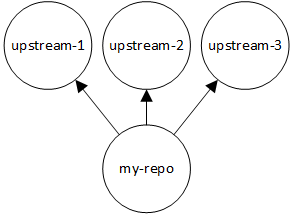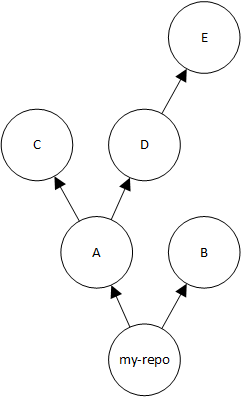Upstream repository priority order
When you request a package version from a repository with one or more upstream
repositories, their priority corresponds to the order that they were listed when calling
the create-repository or update-repository command. When the
requested package version is found, the search stops, even if it didn't search all upstream
repositories. For more information, see Add or remove upstream repositories
(AWS CLI).
Use the describe-repository command to see the priority order.
aws codeartifact describe-repository --repositorymy_repo--domainmy_domain--domain-owner111122223333
The result might be the following. It shows that the upstream repository priority is
upstream-1 first, upstream-2 second, and
upstream-3 third.
{ "repository": { "name": "my_repo", "administratorAccount": "123456789012", "domainName": "my_domain", "domainOwner": "111122223333", "arn": "arn:aws:codeartifact:us-east-1:111122223333:repository/my_domain/my_repo", "description": "My new repository", "upstreams": [ { "repositoryName": "upstream-1" }, { "repositoryName": "upstream-2" }, { "repositoryName": "upstream-3" } ], "externalConnections": [] } }
Simple priority order example
In the following diagram, the my_repo repository has three upstream
repositories. The priority order of the upstream repositories is
upstream-1, upstream-2, upstream-3.

A request for a package version in my_repo searches the repositories in
the following order until it is found, or until an HTTP 404 Not Found
response is returned to the client:
-
my_repo -
upstream-1 -
upstream-2 -
upstream-3
If the package version is found, the search stops, even if it didn't look in all
upstream repositories. For example, if the package version is found in
upstream-1, the search stops and CodeArtifact doesn't look in
upstream-2 or upstream-3.
When you use the AWS CLI command list-package-versions to list package
versions in my_repo, it looks only in my_repo. It does not
list package versions in upstream repositories.
Complex priority order example
If an upstream repository has its own upstream repositories, the same logic is used
to find a package version before moving to the next upstream repository. For example,
suppose that your my_repo repository has two upstream repositories,
A and B. If repository A has upstream
repositories, a request for a package version in my_repo first looks in
my_repo, second in A, then in the upstream repositories of
A, and so on.
In the following diagram, the my_repo repository contains upstream
repositories. Upstream repository A has two upstream repositories, and
D has one upstream repository. Upstream repositories at the same level
in the diagram appear in their priority order, left to right (repository A
has a higher priority order than repository B, and repository
C has a higher priority order than repository D).

In this example, a request for a package version in my_repo looks in the
repositories in the following order until it is found, or until a package manager
returns an HTTP 404 Not Found response to the client:
-
my_repo -
A -
C -
D -
E -
B